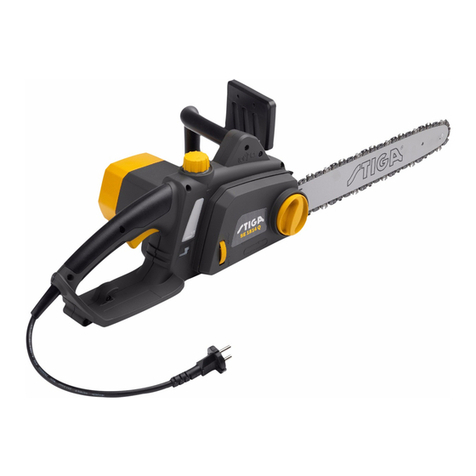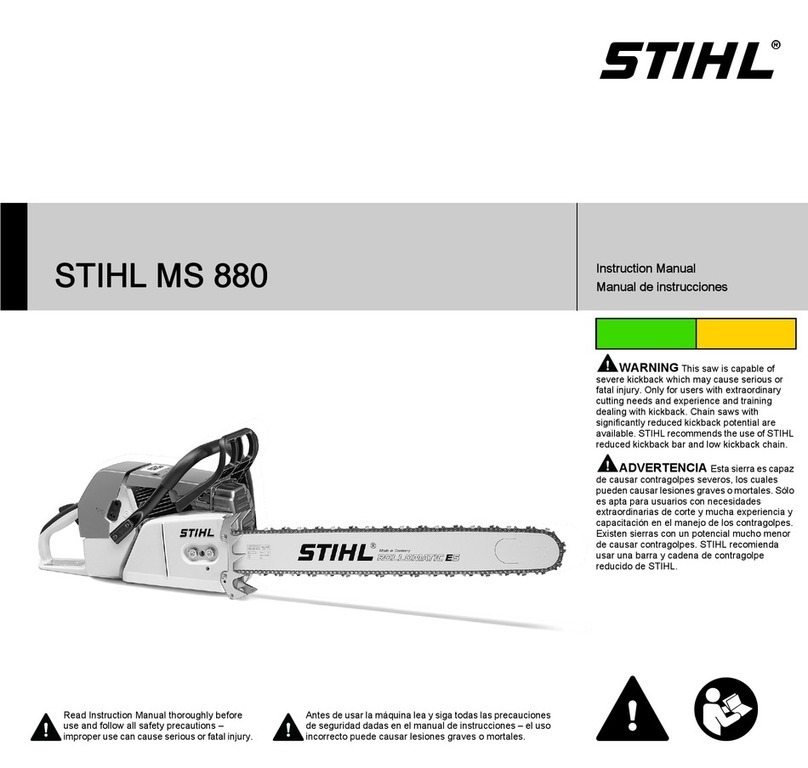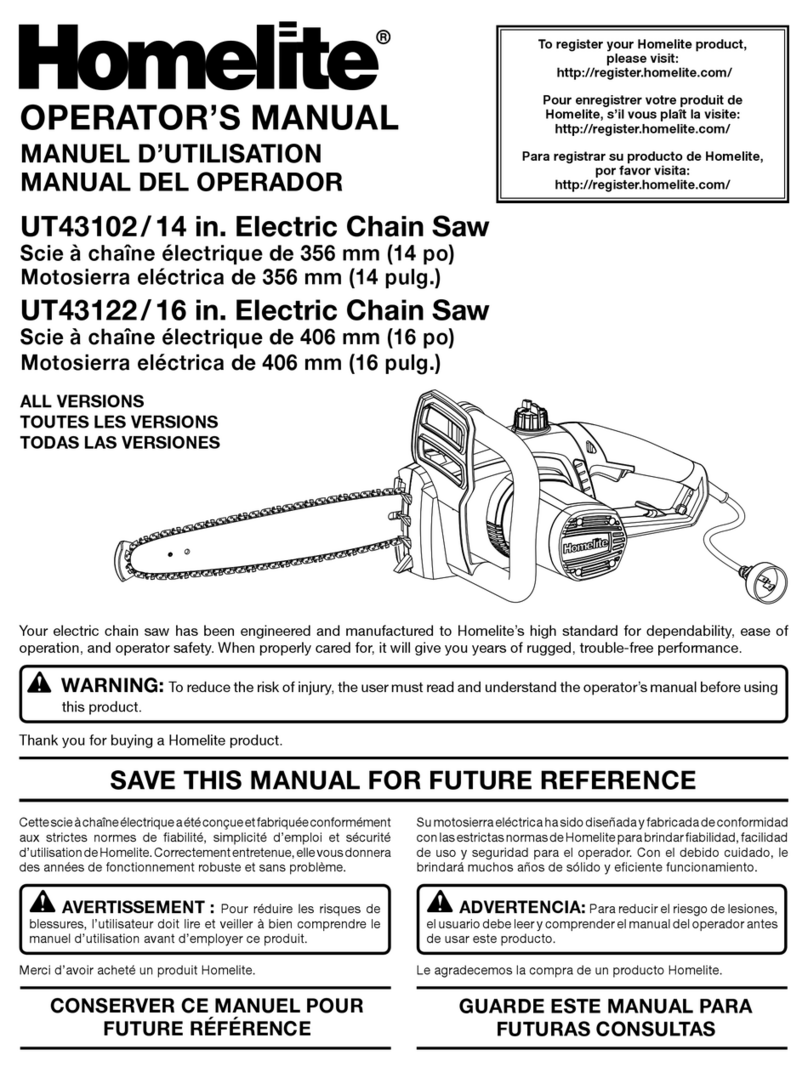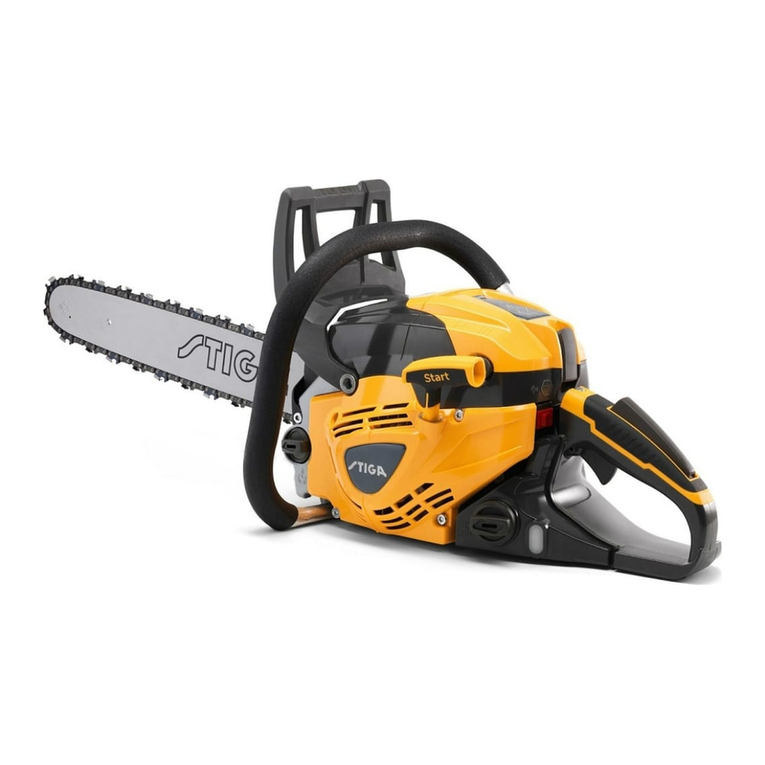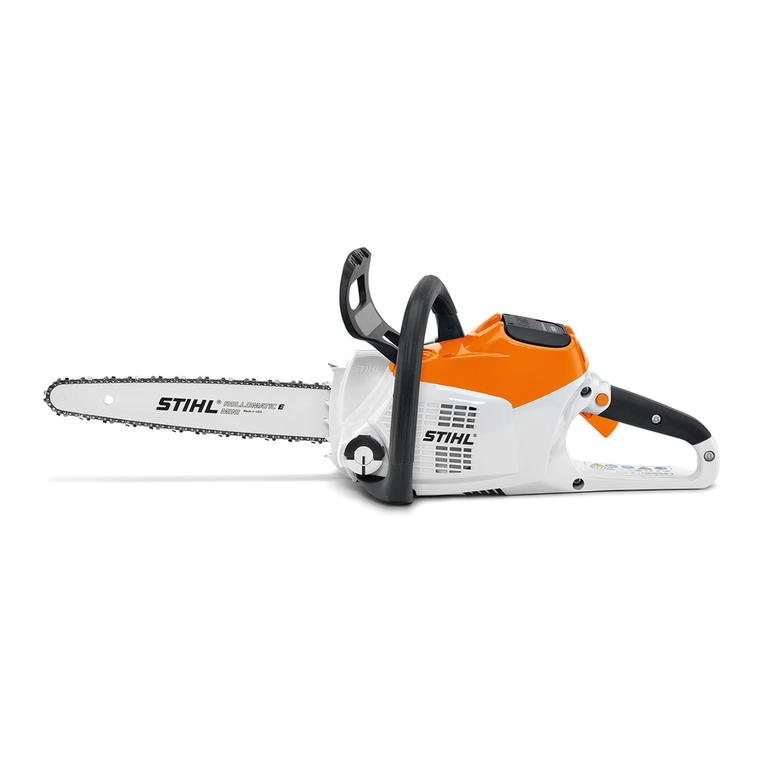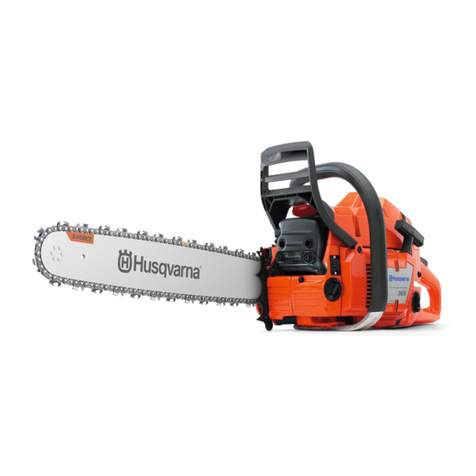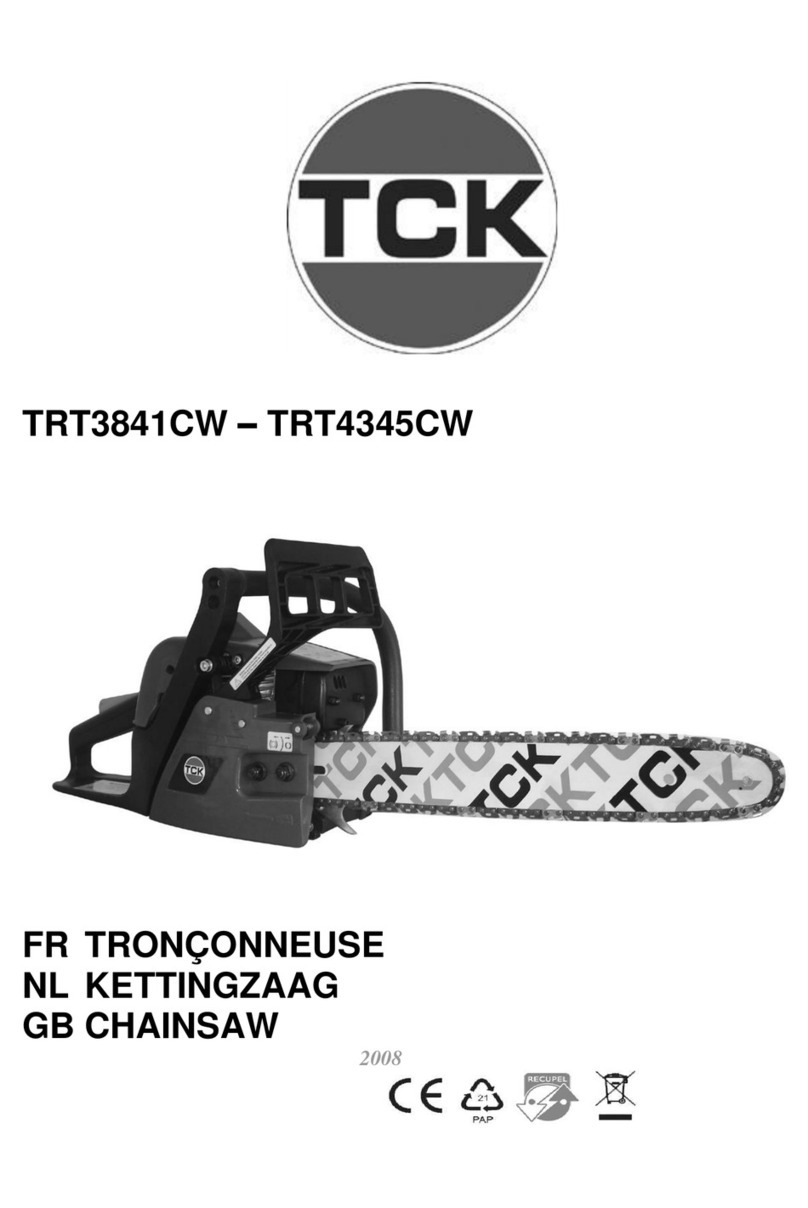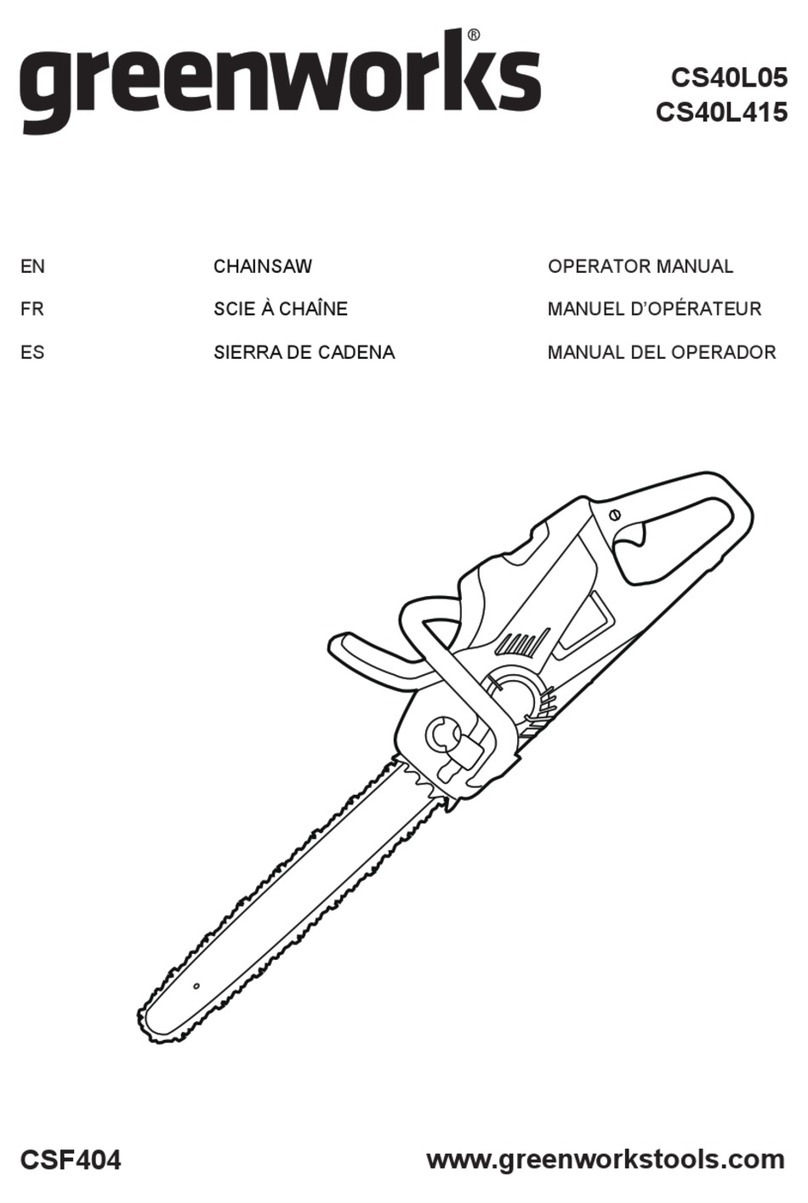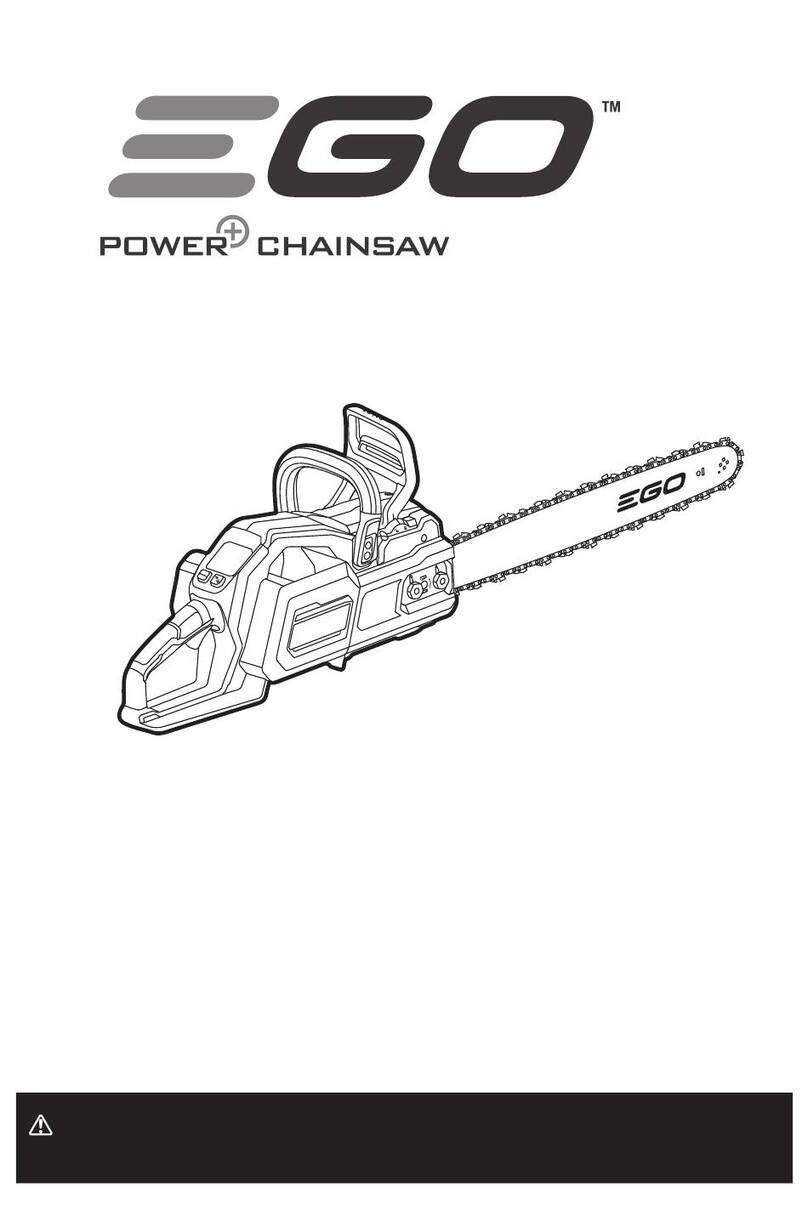Erbauer ECSG18-Li User manual

ECSG3640-Li
EAN: XXXXXXXXXXXXXX
ORIGINAL INSTRUCTIONS
ECSG18-Li
EAN:3663602461982
MNL_ECSG3640-Li_EN_V02_BX220IM_200824

2
Product description
Safety instructions
Assembly
Use
Care & maintenance
Guarantee
Declaration of conformity

3
x1
1
WARNING! Please read all safety warnings carefully and be
sure that they are fully understood before handling the tool.
PRODUCT DESCRIPTION
1. Sprocket wheel
2. Lubrication hole
3. Saw chain
4. Guide bar
5. Ridged bumper
6. Front hand guard
7. Front handle
8. Lock-off button
9. Rear handle
10. Switch trigger
11. Air inlets
12. Battery packs (x2) *
a. Release button*
b. Power bar button*
13. Air outlet
14. Oil level gauge
15. Chain oil tank cap
16. Guide bar cover
17. Drive sprocket cover
18. Chain tension knob
19. Clamping knob
20. Chain tensioning pin
21. Positioning pin
22. Thread hole
23. Drive sprocket
24. Fastening bolt
25. Oiling port
26. Chain direction indicator
27. Positioning hole
Parts marked with * are not included.

4
Product description
1
16
76542 31 8
10
11
12*
13
15 14
17 18 19 12b*
12a*
20 21 22
27
23 25 2624
9

5
A
1.
2.
B
12b
76-100 %
51-75 %
26-50 %
5-25 %
< 5 %
C D
18 19
E F
G
5 mm
H
6
2120 22
23 243 26
27
4
24

6
I J
K L
M
50 mm
50 mm
A
B
C
N
O P

7
Q R
S T
U
2.
1.
1 2 V

8
Safety instructions
GENERAL POWER TOOL SAFETY WARNING
WARNING Read all safety warnings, instructions, illustrations
Failure to follow
serious injury.
The term “power tool” in the warnings refers to your mains-operated
(corded) power tool or battery-operated (cordless) power tool.
1) WORK AREA SAFETY
a) Keep work area clean and well lit. Cluttered or dark areas invite accidents.
b)
Power tools create sparks
which may ignite the dust or fumes.
c)
Distractions can cause you to lose control.
2) ELECTRICAL SAFETY
a)
b)
radiators, ranges and refrigerators. There is an increased risk of electric
shock if your body is earthed or grounded.
c) Do not expose power tools to rain or wet conditions. Water entering a
power tool will increase the risk of electric shock.
d)
Damaged or entangled cords increase the risk of electric
shock.
e)
outdoor use.Use of a cord suitable for outdoor use reduces the risk of electric
shock.
f)
Use of an RCD reduces
the risk of electric shock.

9
3) PERSONAL SAFETY
a)
A moment of
inattention while operating power tools may result in serious personal injury.
b) Always wear eye protection.
Protective equipment such as dust mask, non-skid safety shoes, hard hat, or
hearing protection used for appropriate conditions will reduce personal injuries.
c)
before connecting to power source and/or battery pack, picking up or
energising power tools that have the switch on invites accidents.
d)
A wrench or a key left attached to a rotating part of the power tool may result
in personal injury.
e) This
enables better control of the power tool in unexpected situations.
f)
Loose clothes, jewellery or
long hair can be caught in moving parts.
g)
Use
of dust collection can reduce dust-related hazards.
h)
A careless action
can cause severe injury within a fraction of a second.
4) POWER TOOL USE AND CARE
a)
application. The correct power tool will do the job better and safer at the rate
for which it was designed.
b) Any
power tool that cannot be controlled with the switch is dangerous and must
be repaired.
c)
Such preventive safety
measures reduce the risk of starting the power tool accidentally.
d)
Power tools are dangerous in the hands of untrained users.
e)
tool repaired before use. Many accidents are caused by poorly maintained
power tools.

10
f) Properly maintained cutting tools with
sharp cutting edges are less likely to bind and are easier to control.
g)
Use of the power tool for operations different from
those intended could result in a hazardous situation.
h)
grease. Slippery handles and grasping surfaces do not allow for safe handling
and control of the tool in unexpected situations.
5) BATTERY TOOL USE AND CARE
a) A charger
used with another battery pack.
b) Use of
c)
Shorting the
d)
Liquid ejected from the
battery may cause irritation or burns.
e) Damaged
explosion or risk of injury.
f)
g)
6) SERVICE
a)
This will ensure that the safety of the power
tool is maintained.
b) Service of battery packs should
only be performed by the manufacturer or authorized service providers.
CHAIN SAW SAFETY WARNINGS
•
A moment of inattention while operating chain saws may
cause entanglement of your clothing or body with the saw chain.

11
•
Holding the chain saw with a reversed hand
•
Saw chains contacting a “live” wire may make
exposed metal parts of the power tool “live” and could give the operator an electric
shock.
•
Adequate protective clothing
• Operation of a chain saw while up in a tree
may result in personal injury.
•
Slippery or unstable surfaces such as ladders
may cause a loss of balance or control of the chain saw.
•When
•The slender material
may catch the saw chain and be whipped toward you or pull you off balance.
•
Proper handling of the chain saw will reduce the likelihood of
accidental contact with the moving saw chain.
•
accessories. Improperly tensioned or lubricated chain may either break or
increase the chance for kickback.
•Greasy, oily handles are
slippery causing loss of control.
•
Use of the chain saw for operations different than intended
could result in a hazardous situation.
Kickback may occur when the nose or tip of the guide bar touches an object, or when
the wood closes in and pinches the saw chain in the cut.
Tip contact in some cases may cause a sudden reverse reaction, kicking the guide bar
up and back towards the operator.
Pinching the saw chain along the top of the guide bar may push the guide bar rapidly
back towards the operator.
Either of these reactions may cause you to lose control of the saw which could result in
serious personal injury. Do not rely exclusively upon the safety devices built into your
saw. As a chain saw user, you should take several steps to keep your cutting jobs free
from accident or injury.

12
Kickback is the result of tool misuse and/or incorrect operating procedures or conditions
and can be avoided by taking proper precautions as given below:
•
allow you to resist kickback forces. Kickback forces can be controlled by the
operator, if proper precautions are taken. Do not let go of the chain saw.
•This helps prevent
unintended tip contact and enables better control of the chain saw in unexpected
situations.
•
•
Decreasing the depth gauge height can lead to increased kickback.
ADDITIONAL SAFETY WARNINGS FOR CHAIN SAW OPERATION
• Always remove the battery pack before assembling, adjusting or cleaning, and
before leaving the machine unattended for any period.
• Checking the completeness, assembly and setting of the chain saw (see details
below) before start to work. Repeat the checking regularly during your work.
• It is recommended that the unexperienced user should have practical instruction
in the use of the chainsaw and the protective equipment from an experienced
operator. The initial practice should be cutting logs on a saw horse or cradle.
• Children and juveniles, with the exception of apprentices older than 16 years and
under supervision, may not operate the chain saw. The same applies for persons
•
must not operate the chain saw.
• Wait until the chain has come to a standstill completely before placing it down.
• Ensure that the air vents are always unobstructed and clear. Clean them if
necessary with a soft brush. Blocked air vents may lead to overheating and
damage the product.
• Switch the product off immediately if you are disturbed while working by other
people entering the working area.
• Do not overwork yourself. Take regular breaks to ensure you can concentrate on
the work and have full control over the product.
• Never work with the tip of the chain.

13
BATTERY PACK SAFETY WARNINGS
• Inserting
the battery pack into machines that have the switch on can cause accidents.
• Use of
• Danger of short-circuiting.
•
Danger of explosion.
•
The vapours
can irritate the respiratory system.
•
This measure alone protects the battery against dangerous overload.
•
or by force applied externally. An internal short circuit can occur and the battery
can burn, smoke, explode or overheat.
• There is danger of explosion.
• Use the battery only within a temperature range between 0 °C and 40 °C. As an
example, do not leave the battery in the car in summer.
• If you intend to store a battery for a period without use then store the battery at
room temperature (19 °C to 25 °C), charged to approx. 30 – 50% of capacity.
When storing for very long periods boost charge the battery once per year to
prevent over-discharge.
• Occasionally clean the venting slots and contact pins of the battery pack using a
soft, clean and dry brush.
VIBRATION AND NOISE REDUCTION
To reduce the impact of noise and vibration emission, limit the time of operation, use
low-vibration and low-noise operating modes as well as wear personal protective
equipment.
Take the following points into account to minimise the vibration and noise exposure
risks:
1. Only use the product as intended by its design and these instructions.
2. Ensure that the product is in good condition and well maintained.
3. Use correct attachments for the product and ensure they are in good condition.
4. Keep tight grip on the handles/grip surface.
5. Maintain this product in accordance with these instructions and keep it well
lubricated (where appropriate).
6. Plan your work schedule to spread any high vibration tool use across a longer
period of time.
7. Prolonged use of the product exposes the user to vibrations that can cause a range
of conditions collectively known as hand-arm vibration syndrome (HAVS) e.g.
To reduce this risk when using the product, always wear protective gloves and
keep your hands warm.

14
EMERGENCY
Familiarise yourself with the use of this product by means of this instruction manual.
Memorise the safety directions and follow them to the letter. This will help to prevent
risks and hazards.
a) Always be alert when using this product, so that you can recognise and handle
risks early. Fast intervention can prevent serious injury and damage to property.
b) Switch off and remove the battery pack if there are malfunctions. Have the power
operate it again.
RESIDUAL RISKS
Even if you are operating this product in accordance with all the safety requirements,
potential risks of injury and damage remain. The following dangers can arise in
connection with the structure and design of this product:
1. Health defects resulting from vibration emission if the product is being used over
long periods of time or not adequately managed and properly maintained.
2. Injuries and damage to property due to broken attachments or the sudden impact
of hidden objects during use.
3.
accessories.
WARNING!
or passive medical implants! To reduce the risk of serious or fatal injury,
we recommend persons with medical implants to consult their doctor and
the medical implant manufacturer before operating this product!
Assembly
01 Unpacking
1.
2. Remove all packing materials and shipping devices, if applicable.
3.
that parts are missing or show damage do not use the product but contact your
dealer. Using an incomplete or damaged product represents a hazard to people
and property.
4. Ensure that you have all the accessories and tools needed for assembly and
operation. This also includes suitable personal protective equipment.

15
WARNING! The product must be fully assembled before operation!
Do not use a product that is only partly assembled or assembled with
damaged parts!
Wear protective gloves for this assembly work and always lay the product
Follow the assembly instructions step-by-step and use the pictures
provided as a visual guide to easily assemble the product!
Do not insert the battery pack before the power tool is completely
assembled!
WARNING! The product and the packaging are not children’s toys!
Children must not play with plastic bags, sheets and small parts! There is
a danger of choking and suffocation!
02 Battery pack
be used for the product. Always attach or remove the 2 battery packs at
the same time. The product cannot work with one battery pack.
Slide 2 battery packs into the compartments under rear handle one by one until each
of them is securely locked in position.
Depress the battery pack release button (12a) and pull the battery pack out of the
power tool.
WARNING! Remove the battery pack before assembly, cleaning,
adjustments, maintenance, storage and transportation.

16
The Li-Ion battery pack (12) is equipped with a power bar (12b) which is used to give
an indication of the battery pack’s remaining capacity. Press the power bar button (12b)
to check battery capacity as . The LED will stay lit for approximately 5 seconds.
charger
Please refer to the charger instruction manual for details about the charging process.
03
WARNING!
product with chain oil before using it! Never operate the product without
chain oil as this will result in extensive damage to the product! Operating
shorten the product life span and cause rapid wear to the saw chain and
guide bar from overheating!
Adequate lubrication of the saw chain during cutting operations is
essential to minimize friction with the guide bar!
Fill chain oil immediately when the oil level is blow “Min”-indicator on the oil level
gauge (14).
1. Position the product in a way that the chain oil tank cap (15) faces upwards.
2. Open the cap and check the oil level. Fill the tank with chain lubrication oil if the oil
level is more than 2 cm below the inside edge of the tank. We recommend using
chain saw. Never use recycled/old oil. Use of non-approved oil will invalidate the
warranty.
3.
edge of the tank to allow for expansion (Fig. C).
4.
04
WARNING! Use only the guide bar and saw chain according which is
saw is completely assembled. Always wear protective gloves!
1. Loosen the clamping knob (19) anticlockwise and remove the drive sprocket
cover (17, Fig. D).
2. Turn the chain tension knob (18) so that the chain tensioning pin (20) moves
towards the drive sprocket (23) all the way to the stop.

17
3. Fit the saw chain (3) around the guide bar (4) and then over the drive sprocket.
Mark sure that the guide bar is correctly positioned over the fastening bolt (24) and
the saw chain ‘Cutter’ complies with the chain direction indicator (26) on the plastic
housing (Fig. E).
4. Attach the drive sprocket cover (17) to the housing so that the holes/pins and
fastening bolt (24)/thread hole (22) are aligned with each other properly (Fig. F).
Turn the clamping knob clockwise so that the guide bar can still move.
WARNING! Always check the saw chain tension before use, after the
lengthen considerably. This is normal during the break-in period and the
interval between future adjustments will lengthen quickly.
Always maintain proper chain tension! A loose chain increases the risk of
kickback! A loose chain may jump out of the guide bar groove! This may
injure the operator and damage the chain! A loose chain will cause rapid
wear to the chain, guide bar and sprocket!
Tensioning the chain too tightly will overload the motor and cause
correctly tightened chain provides the best cutting characteristics and
lubrication and correct tensioning!
1.
2. Lift up the tip of the guide bar (4) and keep it slight lifted as you adjust the tension.
slightly if necessary.
3. Turn the chain tension knob (18) until all chain sections are just touching the
bottom edge of the guide.
4. Check the chain tension using one hand, by pulling upwards on the chain against
the weight of the product. The correct chain tension is achieved when the saw
chain can be lifted by approx. 5 mm from the guide bar in the centre (Fig. G).
5.
or tight.
6. Pull the saw chain along the upper side of the guide bar by hand (WITH
PROTECTIVE GLOVE) from one end to the other several times. The chain should
feel tight but still move freely.
7.
05
of chain oil, inserting/removing of battery packs, storage and transportation. Remove
the guide bar cover before operation.

18
Use
Intended use
The product is intended for cutting wood logs and limbs. It must not be used for cutting
other materials, such as plastic, stone, metal, wood that contains foreign objects,
or materials that are harmful to health. This product should not be used outside of
domestic premises e.g. for felling trees or lumber work in forested areas.
The product may only be used with the guide bar/saw chain combination stated within
these instructions. The use of other types or sizes is not allowed. With this product
vertical and horizontal cuts can be performed. Longitudinal sections may only be cut
by professionals.
operation and to observe all the instructions therein. This product is intended for
private domestic use only, not for any commercial use. It must not be used for any
purposes other than those described.
Before you start
01 Protection
Controls
01
Hold the chain saw as in working condition. To start the machine, press the lock-off
button (8) and then press the switch trigger (10) and keep it pressed.
To switch off the machine, release the On/Off switch.
02
The kickback brake is a safety mechanism activated through the front hand guard (6)
when kickback occurs. The saw chain stops immediately.

19
The following function check should be carried out before each use and at regular
Intervals:
1. Switch the product on.
2. While the motor is running, engage the kickback brake to position by rolling your
left hand forward against the front hand guard (6). Saw chain (3) and motor should
stop immediately.
3. Release the switch trigger and try to switch the product on.
4. The saw chain and motor shall not start.
5. Release the switch trigger and pull front hand guard backwards to position after
function check.
Operation
WARNING!
day and on what special days products are allowed to be used and
what restrictions apply! Ask your community for detailed information and
observe the regulations in order to preserve a peaceful neighbourhood
and avoid committing administrative offences.
01
The chain oil level and lubrication should be checked after everything else is ready
before cutting.
1.
2.
in Fig. I.
02
1.
operate chain saws safely and effectively. Familiarise yourself with all the controls
and switches. Practise all movements with the product switched off.
2.
and rear handle with the right hand. Fully grip both handles at all times during
operation. Never operate the product using only one hand.
3. Only use the product with a secure stance. Hold the product at the right-hand side
of your body.
4. Ensure that cutting object does not exceed the usable cutting length of the chain
saw. The tip of guide bar shall always be kept at least 5 cm outside the outline of
the wood log.
5. Ensure the saw chain is running at full speed before it makes contact with the
wood. Use the ridged bumper (5) to secure the product onto the wood before
starting to cut and use it as a leverage point while cutting.

20
6. Reset the ridged bumper at a low point when cutting thicker logs by pulling the
product slightly backwards and reposition at lower level to continue sawing. Do not
remove the product completely from the wood.
7. Do not force the saw chain while cutting, let the chain do the work.
8. Do not operate the product with arms fully extended or attempt to saw areas which
9. Optimum sawing is achieved if the chain speed remains constant during cutting.
10. Be careful when reaching the end of the cut. The weight of the product may change
unexpectedly as it cuts free from the wood. This can cause accidents to the legs
and feet. Always remove the product from a wood cut while the product is running.
11. Check the chain tension and oil feeding regularly.
03
1. When bucking and felling operations are being performed by two or more persons
at the same time, the felling operations should be separated from the bucking
operation by a distance of at least twice the height of the tree being felled. Trees
should not be felled in a manner that would endanger any person, strike any utility
line or cause any property damage. If the tree does make contact with any utility
2. The product operator should keep on the uphill side of the terrain as the tree is
likely to roll or slide downhill after it is felled.
3. An escape path should be planned and cleared as necessary before cuts are
started. The escape path should extend back and diagonally to the rear of the
expected line of fall.
4. Before felling is started, consider the natural lean of the tree, the location of larger
branches and the wind direction to judge which way the tree will fall.
5. Remove dirt, stones, loose bark, nails, staples and wire from the tree.
Make the notch (B) 1/3 the diameter of the tree, perpendicular to the direction of falls.
saw chain or the guide bar when the second notch is being made.
Make the felling back cut (A) at least 50 mm higher than the horizontal notching cut.
Keep the felling back cut parallel to the horizontal notching cut. Make the felling back
cut so enough wood is left to act as a hinge. The hinge (C) wood keeps the tree from
twisting and falling in the wrong direction. Do not cut through the hinge.
As the felling gets close to the hinge, the tree should begin to fall. If there is any chance
that the tree may not fall in desired direction or it may rock back and bind the saw chain,
stop cutting before the felling back cut is complete and use wedges of wood, plastic or
aluminum to open the cut and drop the tree along the desired line of fall.
When the tree begins to fall remove the product from the cut, switch off and put the
product down then use the retreat path planned. Be alert for overhead limbs falling and
watch your footing.
This manual suits for next models
1
Table of contents
Other Erbauer Chainsaw manuals


